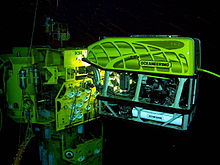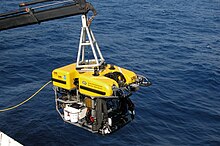Remote controlled underwater vehicle
A remotely operated underwater vehicle (also referred to as a diving robot in the media and in this article ), also referred to in the specialist literature as ROUV or imprecisely as ROV ( remotely operated underwater vehicle ), is a cable-guided underwater vehicle for applications in science and industry and in the military .
description
ROVs are mainly used in the oil industry . Maintenance work, inspections and other work in the offshore area are now mostly carried out by ROVs instead of divers or manned dive boats . This makes it possible to dive much deeper and to work longer under water than would be possible with divers. Compared to manned boats, they are not only more risk-free, but also more economical to use, since, for example, by dispensing with the life support systems, a better use of space is possible.
In addition to industrial use, ROVs are also used for scientific research into the deep sea . The possibility of use in water up to several thousand meters deep means that ecosystems and structures on the sea floor can be researched and sampled. Scientific in-situ experiments on the sea floor can also be carried out using the wired submersible vehicles. The ROV is controlled from a control station on board a research ship and transmits high-resolution video images in real time on board the ship.
While ROVs (with a cable connection English umbilical , umbilical literally) are connected to the energy and information transfer to a surface vessel, come Autonomous Underwater Vehicles (AUV), without such a cable connection and perform their store of energy in accumulators with it. Both solutions have their advantages and disadvantages and serve different purposes. Outwardly, ROVs and AUVs are easy to distinguish. ROVs are mostly frames or scaffolding that are equipped with various components and carry a large number of drive propellers (English thrusters ) to maneuver in all directions. In contrast, AUVs have to use their drive energy sparingly and are therefore clad with a low-resistance outer skin like submarines or torpedoes . AUVs are launched by research vessels in the world's oceans, for example, and programmed to dive into the depths to collect scientific or survey data. They reappear after a predetermined time and transmit this data to a research station via satellite. The data acquisition cycle is repeated until the AUV has finished the job and is "captured" again.
ROVs are available in many different designs and classes, for example Micro ROVs, Mini ROVs, Work-Class ROVs, Multi-Role ROVs (multifunction) and Trencher (trench flushing for laying submarine cables). Smaller ROVs are mostly purely electric and larger ones are electro-hydraulically operated. Micro ROVs weigh from 1.5 kg, including cameras, drives and lights. Trenching systems can weigh up to 20 t. Another example of an ROV is operated by the Dutch dredger company Boskalis . Grabs that are equipped with propellers in order to dredge a larger area on the seabed without having to move the ship (purpose: to protect offshore systems from icebergs that drag over the ground). This example shows that AUVs cannot necessarily be viewed as a better alternative to ROVs due to their conditional intervention options .
ROTV

ROTV s ( remotely operated towed vehicles ) are ROVs without their own drive, they are towed by means of a tow cable. However, they have flaps or similar buoyancy aids.
Examples
- The Japanese diving robot Kaikō dived in 1995 in the Mariana Trench as the first ROV to descend to the deepest point of the sea at 10,911.4 m.
- The Scorpio 45 is a submersible robot that in August 2005 during the liberation of manöverierunfähigen Russian submarine of Pris class before the Kamchatka became -Halbinsel celebrity.
- Another named Snoop Dog first penetrated the premises of the Titanic , which sank in 1912 , for the film Titanic in 1995 and made incomparable recordings.
- Various types were used in the oil spill in the Gulf of Mexico .
- In January 2012 a ROV u. a. used to search for missing persons on the Costa Concordia .
- Specially equipped ROVs are also used when searching for flight recorders from aircraft sunk in the sea or their remains.
- In Attersee , a fatally injured diver was rescued from a depth of 143.5 m by a diving robot on May 13, 2018, thus preventing human divers from descending to an extremely grueling depth.
literature
- Sarah Webster: The Development of Excavation Technology for Remotely Operated Vehicles. in: Robert D. Ballard : Archaeological oceanography. Princeton Univ. Press, Princeton 2008, ISBN 0-691-12940-1 , pp. 41-64.
- Robert D. Christ: The ROV Manual - A User Guide for Observation-Class Remotely Operated Vehicles. Butterworth Heinemann, Oxford 2007, ISBN 978-0-7506-8148-3 .
Web links
Individual evidence
- ^ Alfred Wegener Institute for Polar and Marine Research
- ^ Oil spill - robot army on the seabed derstandard.at, June 26, 2010
- ↑ myvideo.at, posted by zoomin: Costa Concordia - explosions and diving robots. Retrieved February 19, 2014 .
- ^ Missing divers from Attersee salvaged orf.at, May 13, 2018, accessed May 13, 2018.


